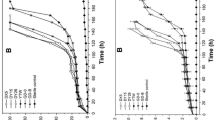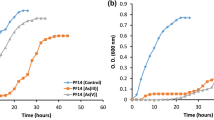Abstract
Heavy metal pollution is widespread causing serious ecological problems in many parts of the world; especially in developing countries where a budget for remediation technology is not affordable. Therefore, screening for microbes with high accumulation capacities and studying their stable resistance characteristics is advisable to define cost-effective any remediation strategies. Herein, the copper-resistome of the novel copper-resistant strain Amycolatopsis tucumanensis was studied using several approaches. Two dimensional gel electrophoresis revealed that proteins of the central metabolism, energy production, transcriptional regulators, two-component system, antioxidants and protective metabolites increased their abundance upon copper-stress conditions. Transcriptome analysis revealed that in presence of copper, superoxide dismutase, alkyl hydroperoxide reductase and mycothiol reductase genes were markedly induced in expression. The oxidative damage of protein and lipid from A. tucumanensis was negligible compared with that observed in the copper-sensitive strain Amycolatopsis eurytherma. Thus, we provide evidence that A. tucumamensis shows a high adaptation towards copper, the sum of which is proposed as the copper-resistome. This adaptation allows the strain to accumulate copper and survive this stress; besides, it constitutes the first report in which the copper-resistome of a strain of the genus Amycolatopsis with bioremediation potential has been evaluated.




Similar content being viewed by others
References
Ahn B, Cha J, Lee E, Han A, Thompson CJ, Roe J (2006) Nur, a nickel-responsive regulator of the Fur family, regulates superoxide dismutases and nickel transport in Streptomyces coelicolor. Mol Microbiol 59:1848–1858
Albarracín VH, Winik B, Kothe E, Amoroso MJ, Abate CM (2008) Copper bioaccumulation by the actinobacterium Amycolatopsis sp. AB0. J Basic Microbiol 48:323–330
Albarracín VH, Alonso-Vega P, Trujillo ME, Amoroso MJ, Abate CM (2010a) Amycolatopsis tucumanensis sp. nov., a novel copper resistant actinobacterium isolated from polluted sediments. Int J Syst Evol Microbiol 60:397–401
Albarracín VH, Amoroso MJ, Abate CM (2010b) Bioaugmentation of copper polluted soil by Amycolatopsis tucumanensis to diminish phytoavailable copper for Zea mays plants. Chemosphere 79:131–137
Alekshun MN, Levy SB (1999) The mar regulon: multiple resistance to antibiotics and other toxic chemicals. Trends Microbiol 7:410–413
Alves AMCR, Euverink GJW, Santos H, Dijkhuizen L (2001) Different physiological roles of ATP- and PPi-Dependent phosphofructokinase isoenzymes in the methylotrophic actinomycete Amycolatopsis methanolica. J Bacteriol 183:7231–7240
Benimeli CS, González AJ, Chaile AP, Amoroso MJ (2007) Temperature and pH effect on lindane removal by Streptomyces sp. M7 in soil extract. J Basic Microbiol 47:468–473
Conrad CC, Choi J, Malakowsky CA, Talent JM, Dai R, Marshall P, Gracy RW (2001) Identification of protein carbonyls after two-dimensional electrophoresis. Proteomics 1:829–834
Dávila Costa JS, Albarracín VH, Abate CM (2011a) Cupric reductase activity in copper-resistant Amycolatopsis tucumanensis. Water Air Soil Pollut 216:527–535
Dávila Costa JS, Albarracín VH, Abate CM (2011b) Responses of environmental Amycolatopsis strains to copper stress. Ecotoxicol Environ Saf 74:2020–2028
Dupont CL, Grass G, Rensing C (2011) Copper toxicity and the origin of bacterial resistance—new insights and applications. Metallomics 11:1109–1118
Gallo G, Renzone G, Alduina R, Stegmann E, Weber T, Lantz AE, Thykaer J, Sangiorgi F, Scaloni A, Puglia AM (2010) Differential proteomic analysis reveals novel links between primary metabolism and antibiotic production in Amycolatopsis balhimycina. Proteomics 10:1336–1358
Gudipaty SA, Larsen AS, Rensing C, McEvoy MM (2012) Regulation of Cu(I)/Ag(I) efflux genes in Escherichia coli by the sensor kinase CusS. FEMS Microbiol Lett 330:30–37. doi:10.1111/j.1574-6968.2012.02529.x
Guimara BG, Souchon H, Honore N, Saint-Joanis B, Brosch R, Shepard W, Cole ST, Alzari PM (2005) Structure and mechanism of the alkyl hydroperoxidase AhpC, a key element of the Mycobacterium tuberculosis defense system against oxidative stress. J Biol Chem 280:25735–25742
Haferburg G, Groth I, Möllmann U, Kothe E, Sattler I (2009) Arousing sleeping genes: shifts in secondary metabolism of metal tolerant actinobacteria under conditions of heavy metal stress. Biometals 22(2):225–234
Hamilton CJ, Finlay RMJ, Stewart MJG, Bonner A (2009) Mycothiol disulfide reductase: a continuous assay for slow time-dependent inhibitors. Anal Biochem 388:91–96
Hellberg K, Grimsrud PA, Kruse AC, Banaszak LJ, Ohlendorf DH, Bernlohr DA (2010) X-ray crystallographic analysis of adipocyte fatty acid binding protein (aP2) modified with 4-hydroxy-2-nonenal. Protein Sci 19:1480–1489
Hillas PJ, Soto del Alba F, Oyarzabal J, Wilks A, Ortiz de Montellano PR (2000) The AhpC and AhpD antioxidant defense system of Mycobacterium tuberculosis. J Biol Chem 275:18801–18809
Hillerich B, Westpheling J (2006) A new GntR family transcriptional regulator in Streptomyces coelicolor is required for morphogenesis and antibiotic production and controls transcription of an ABC transporter in response to carbon source. J Bacteriol 188:7477–7487
Hong R, Kang TY, Michels CA, Gadura N (2012) Membrane lipid peroxidation in copper alloy-mediated contact killing of Escherichia coli. Appl Environ Microbiol 78(6):1776
Hustavová H, Havraneková D (1997) The role of thiamine in Yersinia kristensenii resistance to antibiotics and heavy metals. Folia Microbiol (Praha) 42:569–573
Jeyakanthan J, Thamotharan S, Velmurugan D, Rao VSN, Nagarajan S, Shinkai A, Kuramitsue S, Yokoyamag S (2009) New structural insights and molecular-modelling studies of 4-methyl-5-β-hydroxyethylthiazole kinase from Pyrococcus horikoshii OT3 (PhThiK). Acta Cryst F65:978–986
Joshi SG, Cooper M, Yost A, Paff M, Ercan UK, Fridman G, Friedman G, Fridman A, Brooks AD (2011) Nonthermal dielectric-barrier discharge plasma-induced inactivation involves oxidative DNA damage and membrane lipid peroxidation in Escherichia coli. Antimicrob Agents Chemother 55:1053–1062
Krisko A, Radman M (2010) Protein damage and death by radiation in Escherichia coli and Deinococcus radiodurans. Proc Natl Acad Sci 107:14373–14377
Lemire J, Ryan Mailloux R, Auger C, Whalen D, Appanna VD (2010) Pseudomonas fluorescens orchestrates a fine metabolic-balancing act to counter aluminium toxicity. Environ Microbiol 12:1384–1390
Livak KJ, Schmittgen TD (2001) Analysis of relative gene expression data using real-time quantitative PCR and the 2−ΔΔCt method. Methods 25:402–408
Macomber L, Imlay JA (2009) The iron-sulfur clusters of dehydratases are primary intracellular targets of copper toxicity. Proc Natl Acad Sci 106(20):8344–8349
Madeo M, O’Riordan N, Fuchs TM, Utratna M, Karatzas KAG, O’Byrne CP (2012) Thiamine plays a critical role in the acid tolerance of Listeria monocytogenes. FEMS Microbiol Lett 326:137–143
Manteca A, Mäder U, Connolly BA, Sanchez J (2006) A proteomic analysis of Streptomyces coelicolor programmed cell death. Proteomics 6:6008–6022
Mustroph A, Albrecht G, Hajirezaei M, Grimm B, Biemelt S (2005) Low levels of pyrophosphate in transgenic potato plants expressing E. coli pyrophosphatase lead to decreased vitality under oxygen deficiency. Ann Bot 96:717–726
Noinaj N, Guillier M, Barnard TJ, Buchanan SK (2010) TonB-dependent transporters: regulation, structure, and function. Annu Rev Microbiol 64:43–60
Polti MA, Amoroso MJ, Abate CM (2007) Chromium (VI) resistance and removal by actinomycete strains isolated from sediments. Chemosphere 67:660–667
Reeves RE, South DJ, Blytt HJ, Warren LG (1974) Pyrophosphate: d-fructose 6-phosphate 1-phosphotransferase. A new enzyme with the glycolytic function 6-phosphate 1-phosphotransferase. J Biol Chem 249:7737–7741
Reiß S, Pané-Farré J, Fuchs S, François P, Liebeke M, Schrenzel J, Lindequist U, Lalk M, Wolz C, Hecker M, Engelmann S (2012) Global analysis of the Staphylococcus aureus response to mupirocin. Antimicrob Agents Chemother 56:787–804
Rensing C, Grass G (2003) Escherichia coli mechanisms of copper homeostasis in a changing environment. FEMS Microbiol Rev 27:197–213
Sayre LM, Lin D, Yuan Q, Zhu X, Tang X (2006) Protein adducts generated from products of lipid oxidation: focus on HNE and one. Drug Metab Rev 38:651–675
Seiler U, Pape H, Schröder W (1996) A pyrophosphate-dependent phosphofructokinase (PFK) from Actinoplanes sp., abstract 119. In: Abstracts of the VAAM meeting, Bayreuth
Seoane AS, Levy SB (1995) Characterization of MarR, the repressor of the multiple antibiotic resistance (mar) operon in Escherichia coli. J Bacteriol 177:3414–3419
Sevcikova B, Rezuchova B, Homerova D, Kormanec J (2010) The Anti–Anti-Sigma factor BldG is involved in activation of the stress response sigma factor σH in Streptomyces coelicolor A3(2). J Bacteriol 192(21):5674–5681
Shepard W, Haouz A, Graña M, Buschiazzo A, Betton JM, Cole ST, Alzari PM (2007) The crystal structure of Rv0813c from Mycobacterium tuberculosis reveals a new family of fatty acid-binding protein-like proteins in bacteria. J Bacteriol 189:1899–1904
Stock AM, Robinson VL, Goudreau PN (2000) Two-component signal transduction. Annu Rev Biochem 69:183–215
Stoyanov J, Hobman J, Brown N (2001) CueR (YbbI) of Escherichia coli is a MerR family regulator controlling expression of the copper exporter CopA. Mol Microbiol 39:502–512
Vidali M (2001) Bioremediation an overview. Pure Appl Chem 73:1163–1172
Wang J, Chen C (2009) Biosorbents for heavy metals removal and their future. Biotechnol Adv 27:195–226
Wang G, Gong Y, Anderson J, Sun D, Minuk G, Roberts MS, Burczynski FJ (2005) Antioxidative function of L-FABP in L-FABP stably transfected Chang liver cells. Hepatology 42:871–879
Acknowledgments
This work was supported by CIUNT, FONCyT, CONICET, Argentina and DAAD, Germany. J.S.D.C. is supported by a CONICET doctoral scholarship. The authors thank greatly to Lic. María José Vildosa from CERELA-CONICET-TUCUMÁN for her valuable technical contribution in qRT-PCR.
Author information
Authors and Affiliations
Corresponding author
Rights and permissions
About this article
Cite this article
Dávila Costa, J.S., Kothe, E., Abate, C.M. et al. Unraveling the Amycolatopsis tucumanensis copper-resistome. Biometals 25, 905–917 (2012). https://doi.org/10.1007/s10534-012-9557-3
Received:
Accepted:
Published:
Issue Date:
DOI: https://doi.org/10.1007/s10534-012-9557-3




